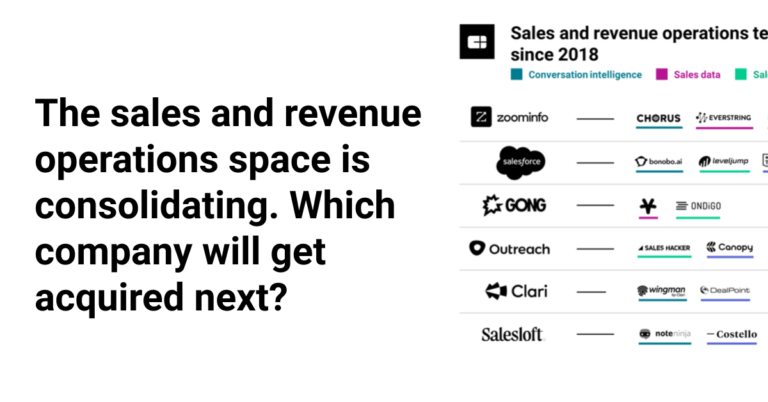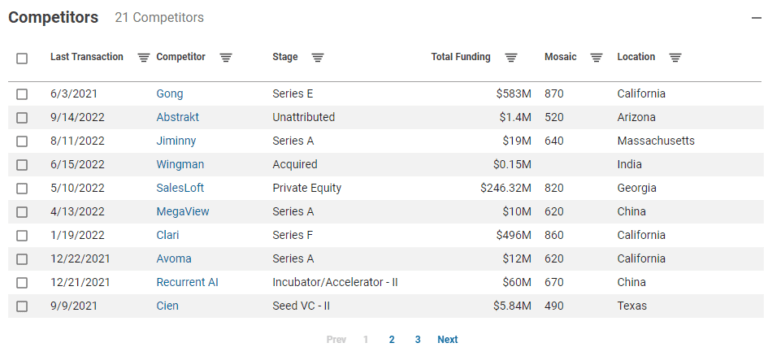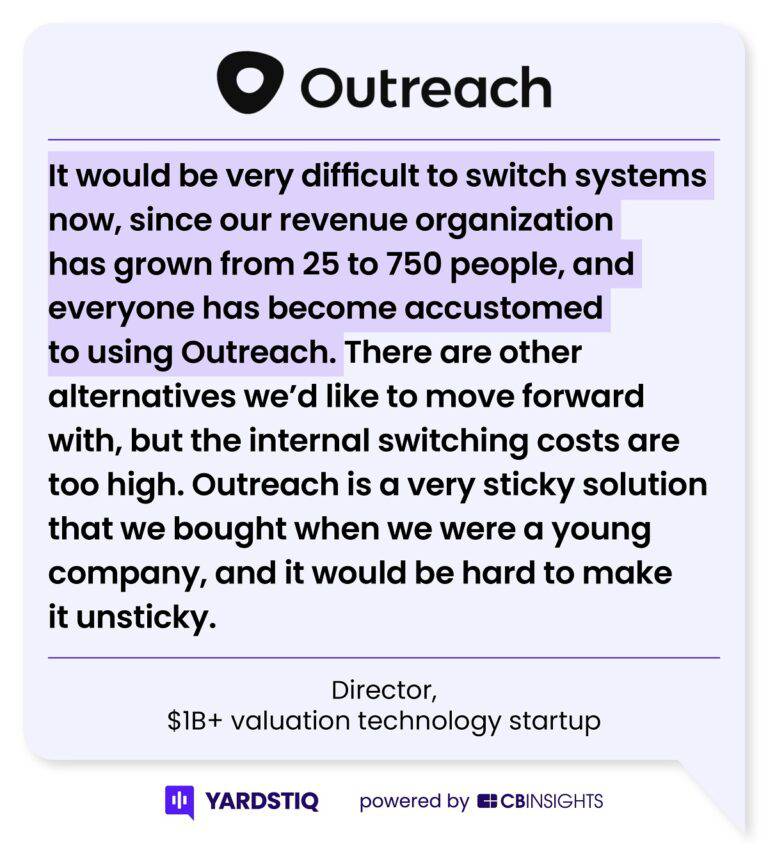
Outreach
Founded Year
2014Stage
Series G - II | AliveTotal Raised
$489.78MRevenue
$0000Mosaic Score The Mosaic Score is an algorithm that measures the overall financial health and market potential of private companies.
-33 points in the past 30 days
About Outreach
Outreach is a sales execution platform that provides tools for sales teams across various business sectors. The company offers tools that use automation and artificial intelligence to assist with sales engagement, deal management, and forecasting processes. Outreach serves market-facing teams within organizations that are looking to improve their revenue cycle and go-to-market strategies. It was founded in 2014 and is based in Seattle, Washington.
Loading...
Outreach's Product Videos


ESPs containing Outreach
The ESP matrix leverages data and analyst insight to identify and rank leading companies in a given technology landscape.
The customer relationship management (CRM) market focuses on managing, nurturing, and optimizing customer relationships. CRM solutions allow businesses to build stronger relationships with their customers, better understand their needs, and create more effective marketing and sales strategies. By utilizing CRM, businesses can increase customer satisfaction, reduce customer churn, and boost custome…
Outreach named as Outperformer among 15 other companies, including Salesforce, ServiceNow, and Oracle.
Outreach's Products & Differentiators
Outreach Engage
Outreach Engage is the industry-leading sales engagement solution for sales and business development reps. With simplified, automated prospecting workflows and winning sales playbooks, reps can build more pipeline and optimize for success.
Loading...
Research containing Outreach
Get data-driven expert analysis from the CB Insights Intelligence Unit.
CB Insights Intelligence Analysts have mentioned Outreach in 5 CB Insights research briefs, most recently on May 2, 2023.



Apr 6, 2023 report
Top data enrichment companies — and why customers chose them
Dec 5, 2022
The Transcript from Yardstiq: The Gong showExpert Collections containing Outreach
Expert Collections are analyst-curated lists that highlight the companies you need to know in the most important technology spaces.
Outreach is included in 4 Expert Collections, including Unicorns- Billion Dollar Startups.
Unicorns- Billion Dollar Startups
1,270 items
Tech IPO Pipeline
825 items
Future Unicorns 2019
50 items
Artificial Intelligence
7,221 items
Outreach Patents
Outreach has filed 15 patents.
The 3 most popular patent topics include:
- artificial intelligence
- natural language processing

Application Date | Grant Date | Title | Related Topics | Status |
|---|---|---|---|---|
8/12/2023 | 3/4/2025 | Artificial intelligence, Natural language processing, Internet of things, Videotelephony, Artificial intelligence researchers | Grant |
Application Date | 8/12/2023 |
|---|---|
Grant Date | 3/4/2025 |
Title | |
Related Topics | Artificial intelligence, Natural language processing, Internet of things, Videotelephony, Artificial intelligence researchers |
Status | Grant |
Latest Outreach News
Mar 25, 2025
Finding your voice takes time and practice. These techniques will help. 28, 2021 DeJuan Brown first found his “sales voice” working in the restaurant industry. Then he took a job as a tech sales rep. Where he had once joked with people, anticipated their needs and connected with them on a personal level, he became stiff on calls , sticking close to the sales techniques he learned. If he heard a rejection, he knew to respond one way. If a prospect had a question, he’d respond another way. “If I reflect back to those days, I would characterize it as more mechanical.” While no one at his job told him he couldn’t be his authentic self in sales, he thought he needed to shun the voice he developed as a bartender and server to succeed. “If I reflect back to those days, I would characterize it as more mechanical,” said Brown, who is now the senior director of global sales at Seismic. “I was very successful, but I didn’t necessarily feel like I was bringing my whole self to the world.” That all changed in 2014 when his manager at a new job encouraged him to have more fun and be himself on sales calls. Slowly, he rediscovered the voice from his bartending days and started differentiating himself as a salesperson. Ultimately, mastering a sales technique isn’t just about knowing what to do — it’s about finding your voice while doing it. It takes time and practice, added Chris Kosrow, who’s a sales manager at Showpad . We spoke with Kosrow, Brown, Outreach Corporate AE Clara Hughes and Yottaa Enterprise AE Nathan Crafts about the techniques they find most useful in sales and how they make those techniques their own. 11 Sales Techniques to Know Focus on smart questions as much as smart answers. Practice transparent negotiating. Respond to rejection with curiosity. Use interesting content to build social engagement. Kick off your discovery calls with a hypothesis slide. Use short calls to check in with your “champion.” Create an account plan for each prospect that tracks each step of the sales journey. Ditch the script on demo calls. Cultivate multiple relationships on an account. Take care of your mental health. DeJuan Brown, Sr. Director of Global Sales, Seismic In Brown’s role at Seismic, he sells to C-level sales and marketing executives at global companies like IBM, Cisco and American Express. He looks at sales techniques as a framework to work from, rather than a formula to use. Be Curious During Your Outreach Every sales rep knows that, the more genuine and personalized their outreach is, the more likely a prospect is to respond. The challenge, however, lies in doing it consistently with every prospect. This is where curiosity comes into play. Brown views curiosity as the framework upon which all outreach and discovery calls are built. It’s not a natural skill either, but a technique that needs to be developed over time. To grow that skill, Brown suggests reading a blog post or listening to a podcast from a specific prospect’s company and reflecting on what you learned from it. Then, challenge yourself to list the questions the content didn’t answer. “We’re all left with questions that went unanswered by the thing we read or listened to.... Let’s ask that question.” Those “I wonder” statements become the heart of personal outreach. The sales rep can reference what they found engaging about the content and ask about what they want to learn from the buyer. “This is not a facade,” Brown said. “We’re all left with questions that went unanswered by the thing we read or listened to.... Let’s ask that question. That then becomes the expression of true curiosity in its rawest form.” Respond to Rejection With Curiosity Curiosity doesn’t end with the discovery call. Brown has found it’s a useful mentality when dealing with rejection too. If a prospect decides the product isn’t right for them, the best thing a sales rep can do is respond with a question. In this case, it’s often simplest to just ask, “What do you mean?” or, “May I ask you to say more?” “If you can get behind the veil of the objection, then perhaps there’s a conversation to be had.” But the question has to come from a place of genuine curiosity, Brown said. If you ask, “What do you mean?” in a perfunctory way, it can come off as defensive or create friction. However, if you are genuinely interested in the prospect’s response, they’re more likely to respond with more information that might end up uncovering a new opportunity. “If you can get behind the veil of the objection, then perhaps there’s a conversation to be had,” Brown said. “Alternatively, there may not be. But taking the objections at face value without a curious mind will probably be less than ideal in terms of your outcomes.” Find out who's hiring. Use Interesting Content to Make New Connections Social selling has become one of the most important tools in a sales rep’s repertoire for building relationships. As email inboxes become cluttered with automated pitches and cold calls get screened to voicemail, LinkedIn and Twitter remain one of the few places a rep can engage with buyers. The best way to do that is to aggregate stories and start sparking conversations, Brown said. “People in the space I’m in are also curious or they have answers ... so we get conversations going on social.” Brown found success using a news app like Flipboard to find stories that were relevant to his audience of buyers. From there, he uses a social media distribution app to schedule his posts with regularity. But the key to making it all work is curiosity. When Brown shares a story, he’ll accompany it with a question. Because of that, people end up gravitating toward his posts, and he’s able to use that as a jumping-off point for connections. “People in the space I’m in are also curious or they have answers ... so we get conversations going on social,” Brown said. “That’s what most people call engagement. I just get to have more conversations about the things I’m interested in and the things I know my people are interested in.” Chris Kosrow, Sales Manager, Showpad Before moving into a sales manager role, Kosrow worked as a mid-market account executive. To him, the best way to find your sales voice is to listen to your own calls and practice new techniques with a peer or manager. Ask the Question Behind the Question There’s a tendency in sales to have an answer for every question the customer has during discovery or a demo, but often, the best reps differentiate themselves with the questions they ask rather than with clever responses. To that end, Kosrow believes there are two questions every sales rep should have in their repertoire — “What else?” and “How do you mean?” Both questions can help a sales rep clarify a customer’s intentions and create a more engaging conversation. Kosrow’s team picked the technique up during a training session by the firm Winning by Design. The first question, “What else?” can initiate conversation after a presentation or an answer to a customer’s question, Kosrow said. It’s a more effective version of the close-ended question, “Does that make sense?” which almost always gets a “yes” response and kills the conversation. By asking, “What else would you like to know?” or, “What else were you hoping to find out about ‘XYZ’?” the prospect is compelled to respond with more clarifying questions or to summarize the points that mattered the most to them, Kosrow said. Find out who's hiring. View Jobs Meanwhile, the question, “How do you mean?” helps a sales rep clarify any questions they don’t fully understand. It’s less confrontational than “I don’t understand,” and it encourages the customer to go into more detail about what they want to learn, Kosrow said. This helps the rep respond with information that the buyer actually wants to know, rather than with what the rep thinks they want to know. Practice Transparent Negotiating Negotiating can sometimes feel like a game of poker, where both parties hide their cards until the very end to get a better deal. Transparent negotiation, which Kosrow learned from sales consultant Todd Caponi , helps ease the tension and create a smoother deal-making process. “It’s a very clear line in the sand, and it just helps you to be super, super direct in your negotiations.” Kosrow does this by showing the customer a slide of all the discounts he can offer up front and what he requires in return. The discounts might require the buyer to purchase more licenses of the product, to sign a longer-term deal or to sign faster. In laying out the deals upfront, the customer knows what they need to do if they want a discount, and Kosrow isn’t put in a position to provide a discount he isn’t comfortable with. “It’s a very clear line in the sand, and it just helps you to be super, super direct in your negotiations,” he said. Clara Hughes, Corporate AE, Outreach Hughes sells to sales leaders at companies ranging in size from 250 to 2,500 employees. Her sales techniques focus on helping people embrace change. Kick Off Your Discovery Calls With a Hypothesis Slide One of Hughes’ favorite parts of sales is seeing the change a customer undergoes when they purchase the product. Of course, change is also what a buyer is most resistant to in the first meeting. To convince a prospect that the work it takes to purchase and adopt her product is worth it, she has to build credibility. And the way she does that is with a hypothesis slide in her sales deck . “Nine times out of 10, when I come with my hypothesis talk track prepared, the conversation goes in a way that promotes next steps in the sales cycle.” The hypothesis slide is the first item on her talk track. This is where she incorporates all of the research she’s done on the buyer’s company and where she thinks Outreach can help. She may include data from the company’s 10K report or a quote from the CEO during a podcast about how the company plans to grow its revenue. She’ll put that information alongside the photo of her prospect and a note about what she believes the prospect’s role and responsibilities include. At the end, she’ll include a theory of how Outreach can help them in that process. The slide doesn’t require any additional work beyond what she’s already doing to prepare for the discovery call. However, by presenting it as a hypothesis, the buyer either believes it’s spot on and is ready to learn more, or they’ll steer her in the right direction. “Nine times out of 10, when I come with my hypothesis talk track prepared, the conversation goes in a way that promotes next steps in the sales cycle,” Hughes said. “Sales leaders love to know they’re important and their org is important and that we can add value to it.” Leverage Your Champion with Half Calls One of the biggest professional challenges for Hughes during the pandemic has been maintaining momentum on deals. Keeping the deal moving has always been a challenge when selling into enterprise companies with drawn-out buying processes, but it’s become more difficult as those same firms deal with the uncertainty that’s come with COVID-19. So, Hughes turned to having weekly “half calls” with her champion. The champion is an employee at the buying company who is committed to the product and willing to promote it internally. She uses the weekly half call to prepare her champion for upcoming events and catch up on any internal changes within the company she needs to be aware of. “It gets me to the right people, it gives me insight that I may not have asked for if I didn’t have that relationship and it helps me stay on top of timing.” She typically sets up the meeting via text and has a specific topic in mind to discuss, whether that’s gathering more metrics to a high-level goal or going over the slides in an upcoming meeting. The frequent communication helps her build trust with the champion and gauge the deal’s progress. “It gets me to the right people, it gives me insight that I may not have asked for if I didn’t have that relationship and it helps me stay on top of timing,” Hughes said. Create an Account Plan There’s more to sales than just building relationships. The best reps also keep meticulous notes on their prospects and where they’re at in the deal. To aid with that, Hughes suggests maintaining an account plan for top-tier accounts. The account plan can be built on a spreadsheet and includes important information about the company, key stakeholders and a 30-60-90-day plan. “It helps me take previous knowledge of what worked and what didn’t into new accounts that I want to get out in front of.” The plan helps her identify who she needs to speak with at each stage and acts as a checklist to make sure she isn’t missing any steps in the deal cycle. She’ll then take detailed notes throughout the process, which she refers back to for plays to run on future deals. “It helps me take previous knowledge of what worked and what didn’t into new accounts that I want to get out in front of,” Hughes said. Find out who's hiring. Nathan Crafts, Enterprise AE, Yottaa Crafts sells to people in marketing, e-commerce and IT roles within Fortune 500 e-commerce companies. Early in his career, Crafts tried to read as many sales methodology books as possible. While he was drawn to the psychology behind sales, he learned that psychological tricks alone would lead to a high turnover in deals. For him, the key is to take the time to add your own voice to the conversation and relate to buyers. Ditch the Script on Demo Calls If there’s one thing Crafts has learned selling remotely, it’s that buyers are tired of sales decks ... and listening to rehearsed scripts ... and Zoom calls. The best way to keep a buyer’s attention during a virtual call is to approach it like you would a conversation with someone at a bar, Craft said. “It’s hard sometimes to shed the costume or front that we put on everyday as salespeople. Remember, we’re speaking with people when we engage.” To set up a more inviting atmosphere, Crafts suggests setting the cameras default to “off” for the buyer. That way, they have the choice to make it a video call or to keep it off. From there, he tries to make his discovery conversational. He’ll try to find common ground with the prospect based on the research he’s done and perhaps ask them questions about what made them take the call. This helps create a natural entry point into a conversation and alleviates some of the formality that comes with a virtual sales call. “We need to be human,” Crafts said. “It’s hard sometimes to shed the costume or front that we put on everyday as salespeople. Remember, we’re speaking with people when we engage.” Cultivate Multiple Relationships Within an Account When Crafts sells into enterprise companies, he tries to build a relationship with someone in the product-user tier, the manager tier and at the leadership level. Since enterprise deals can have eight or more stakeholders involved, the multi-threaded sales approach ensures he’s addressing the needs of most people in the room to keep the deal on track. The key to building those connections is to set up individual meetings with a person in each tier, Crafts said. When stakeholders are in group meetings, they’re not as likely to voice their concerns. So, he works with his champion to introduce him to their manager or to a senior leader. During those conversations, he’s able to understand what motivates them and what their KPIs are, which, in turn, helps him provide more relevant information about the product. Ultimately, one champion is often not enough to close a deal. While they can be a useful ally, it’s important to broaden your reach within a company, Crafts said.
Outreach Frequently Asked Questions (FAQ)
When was Outreach founded?
Outreach was founded in 2014.
Where is Outreach's headquarters?
Outreach's headquarters is located at 333 Elliott Avenue West, Seattle.
What is Outreach's latest funding round?
Outreach's latest funding round is Series G - II.
How much did Outreach raise?
Outreach raised a total of $489.78M.
Who are the investors of Outreach?
Investors of Outreach include M12, CrossWork, Mayfield, Trinity Ventures, Lone Pine Capital and 26 more.
Who are Outreach's competitors?
Competitors of Outreach include Aomni, Scalestack, SalesLoft, Sales Marker, Pitchit and 7 more.
What products does Outreach offer?
Outreach's products include Outreach Engage and 2 more.
Who are Outreach's customers?
Customers of Outreach include Honeycomb, Fast, Gravity Payments and Sisense.
Loading...
Compare Outreach to Competitors

Salesloft provides revenue growth and efficiency solutions within the sales technology sector. Its main offering is a Revenue Orchestration Platform that helps sales teams prioritize and act on buyer signals, manage pipelines, and forecast sales outcomes. The platform is used by revenue operations, sales leaders, and customer success teams, and includes tools for technology and workflow optimization, team productivity, and customer engagement. It was founded in 2011 and is based in Atlanta, Georgia.

Aviso provides a revenue operating system that focuses on sales activities within the sales sector. It offers tools for sales forecasting, pipeline management, and deal guidance to assist go-to-market (GTM) teams in their sales processes. Aviso's platform is used by enterprise and high-growth companies to manage revenue operations. The company was founded in 2012 and is based in Redwood City, California.

Highspot provides a sales enablement platform. The platform includes managing sales content, executing sales plays and playbooks, engaging buyers, onboarding and training sales representatives, and providing sales coaching, supported by analytics and AI technology. Highspot serves sectors, including financial services, manufacturing, healthcare, life sciences, and technology. It was founded in 2012 and is based in Seattle, Washington.
Addvocate specializes in providing sales strategies through the integration of artificial intelligence (AI) and customer feedback within the sales technology sector. The company offers AI-driven tools that provide personalized sales insights and strategies. Addvocate's solutions are designed to cater to the needs of sales professionals seeking to optimize their sales cycles and strategies. It was founded in 2024 and is based in Paris, France.

Clari focuses on improving efficiency, predictability, and growth in the revenue process, operating in the technology and business services sectors. The company offers a revenue platform that provides total visibility into businesses, driving process rigor, spotting risk and opportunity in the pipeline, increasing forecast accuracy, and enhancing overall efficiency. It primarily serves sales, marketing, and customer success teams across various industries. It was founded in 2012 and is based in Sunnyvale, California.

People.ai is a company that provides an AI data platform for go-to-market teams. The company offers products for sales activities such as account planning, deal inspection, content generation, account enablement, and forecasting, utilizing a data foundation and generative AI capabilities. People.ai serves sectors that require sales and revenue operations solutions, utilizing AI technology to enhance sales processes. It was founded in 2016 and is based in San Francisco, California.
Loading...

